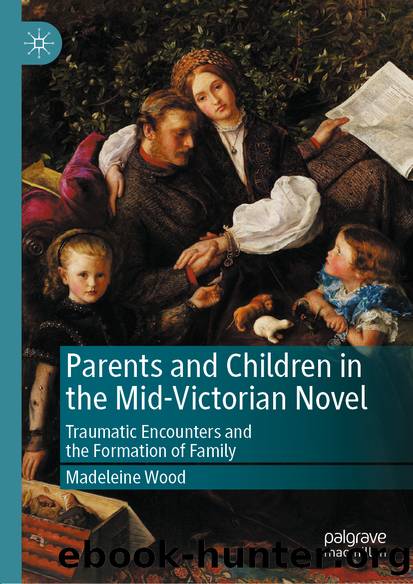Parents and Children in the Mid-Victorian Novel by Madeleine Wood

Author:Madeleine Wood
Language: eng
Format: epub
ISBN: 9783030454692
Publisher: Springer International Publishing
Arrested Development
The traumatic structuring of Dombey is by no means linear or straightforward; as in Freudâs own case histories, the identification of a stable âoriginâ is inherently problematic. In Freudâs history of Lucy R. (discussed in Chapter 2), the key traumatic scenes constantly referred back to an earlier moment. While in Dombeyâs traumatic structure the two maternal losses are undoubtedly central, Paulâs christening is also a key moment, referring back to his birth, as well as looking forward with a gloomy premonition to his sentimental demise and subsequent interment: two very private moments, flanked neatly by their social performances. Although we are told that Paul âpined and wasted after the dismissal of his nurseâ, the atmosphere of the christening is also retrospectively interpreted as a negative influence, the narrator speculating that âThe chill of Paulâs christening had struck home, perhaps, to some sensitive part of his natureâ (Ch. 8, 91). Dickens juxtaposes the private (maternal) losses, with the public (paternal) ceremonies, reinforcing the tension between maternal and paternal culpability in Paulâs demise. In this christening scene, Dickens reminds us that the crisis set in motion by the opening scene was not only one of maternal loss, but also of intrusive paternal fantasy. Paul is born into death: his motherâs and his own. The christening is a freezing affair: the narrator notes, the âchief difference between the christening party and a party in a mourning coach, consisted in the colours of the carriage and horsesâ (Ch. 5, 58): âIt happened to be an iron-grey autumnal day, with a shrewd east wind blowing â a day in keeping with the proceedingsâ (54). Paul is welcomed into a deathly world: âdusty urn[s]â adorning the drawing room, as if âdug up from an ancient tombâ. Melancholy details abound; even the leaves fall âblightedâ as autumn passes into winter. The âchimney-glassâ bears witness to Dombey and his portrait and âseemed fraught with melancholy meditationsâ. With this image, Dickens subtly implies the function that Paul (as well as the christening) serves in Dombeyâs narcissistic conception of self. Dickens constructs the scene with a moralising and sustained symbolism. In the church, Mr. Chick accidentally reads out âthe reference to Mrs. Dombeyâs tomb in full, before he could stop himselfâ (Ch. 5, 59). Maternal loss, melancholia and premature death: all are invoked. Dombeyâs emotional frigidity is extended to his surroundings, and, with a typical Dickensian flourish, affect permeates even the food:âThis,â returned Mr. Dombey, âis some cold preparation of calfâs head, I think. I see cold fowls â hams â patties â salad â lobster. Miss Tox will do me the honour of taking some wine? Champagne to Miss Tox.â
There was toothache in everything. (Ch. 5, 60â61)
Download
This site does not store any files on its server. We only index and link to content provided by other sites. Please contact the content providers to delete copyright contents if any and email us, we'll remove relevant links or contents immediately.
The Lamplighters by Emma Stonex(1340)
Sisters by Daisy Johnson(1337)
The Burying Place (The DI Rachel Morrison series Book 1) by Vicky Jones & Claire Hackney(1291)
Remember by Lisa Genova(1182)
The Secret of You and Me by Melissa Lenhardt(1169)
Expect a Miracle by Danielle Steel(1167)
The End of Men by Christina Sweeney-Baird(1140)
The Castaways by Lucy Clarke(1046)
The Personal Librarian by Marie Benedict & Victoria Christopher Murray(889)
Seven Kinds of People You Find in Bookshops by Shaun Bythell(883)
The Liar's Dictionary by Eley Williams(880)
Everything After by Jill Santopolo(833)
The Marriage Moment by Katie Meyer(828)
The Mystery of Mrs. Christie by Marie Benedict(819)
A Family Affair by Lance Edwards(808)
The Russia House by John Le Carré(782)
The Handmaidâs Tale by Margaret Atwood(779)
ANTONIO TABUCCHI by Sostiene Pereira (Ita Libro)(766)
The Boy in the Field by Margot Livesey(763)
